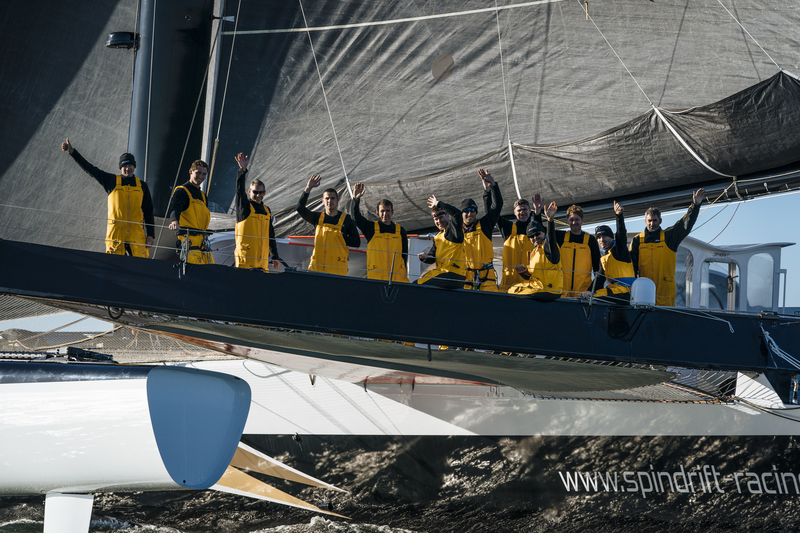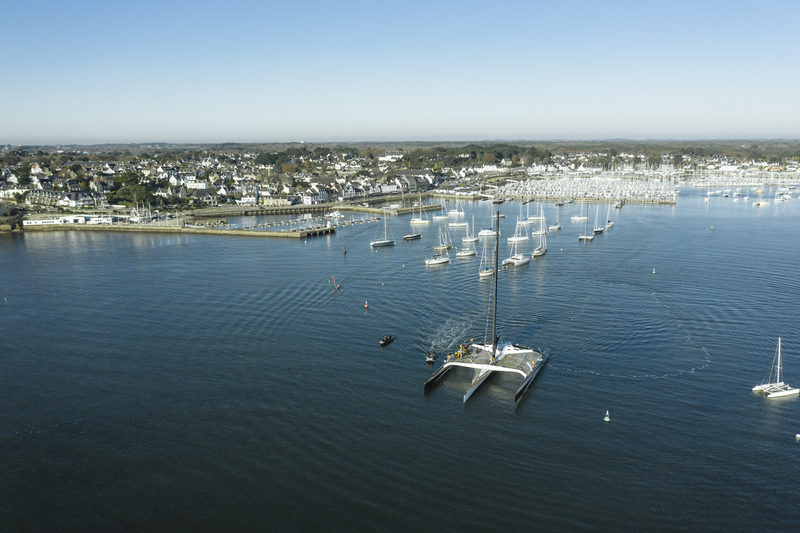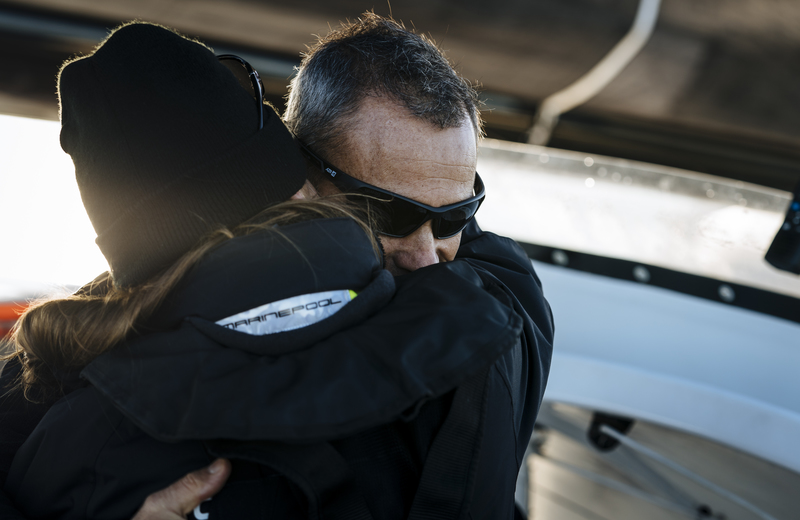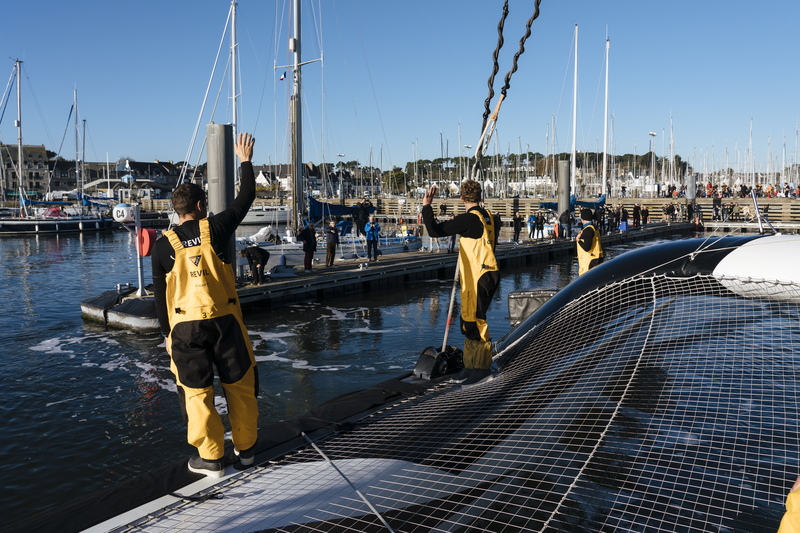
LA TRINITE-SUR-MER, FRANCE, DECEMBER 3rd 2019: Spindrift racing at the start of the Jules Verne Trophy.

Yann Guichard and his eleven crew left the dock in La Trinité-sur-Mer today (Tuesday) at 1130hCET to make their way to the start line of the Jules Verne Trophy. It is anticipated that the maxi trimaran will cross the line off the Créac’h Lighthouse (Ushant) at about 2100hCET this evening. With the current moderate easterly sea breeze, Spindrift should take between six to seven hours to reach the start line area.

©Chris Schmid / Spindrift racing
There were some emotional scenes when the twelve-strong Spindrift 2 crew said their goodbyes to relatives and friends on the pontoon at La Trinité-sur-Mer, before setting off for their forty-day record-breaking attempt around the world. As black and gold trimaran eased its way out of the harbour in bright sunshine and a steady easterly breeze, they hoisted their mainsail at the mouth of the river and setting their bows toward the start line at the Créac’h Lighthouse at Ushant, some six to seven hours away. It was a peaceful start and this same tempo looks set to accompany them, as the conditions in the Bay of Biscay look calm and flat for the first few hours of this third attempt on the record. Five days and dust …
Five days and dust … “There is a good weather window that shows us reaching the equator in a little over five days and the South Atlantic seems to be improving so, hopefully the first section of this record will be good. Spindrift 2 has two new rudders that will allow us to further improve on performance but nevertheless, the record will be difficult to beat! Whatever happens, it is an incredible voyage, and it’s still a human, technical and sports adventure. The crew is really motivated and my core team that has been part of this journey before. So we will leave the Bay of Biscay in relatively quiet conditions before accelerating significantly after Cape Finisterre … “said Yann Guichard before leaving the dock. Spindrift 2 is due to start the 21,600 mile course on Tuesday, December 3 at 2100h CET. The course is marked by three legendary capes: Good Hope (south of the African continent), Leeuwin (south-west of Australia), Horn (south of the American continent). This is the team’s third attempt at targeting the 40d 23h 30 ’30’ record around the world.
“You have to be persistent in the Jules Verne Trophy! First you need a good, well-prepared boat, good chemistry amongst the crew and of course, favourable weather conditions. The conditions look to be relatively easy at first, which will give us a nice descent to the Equator. We anticipate that we should be able to reach the Cape of Good Hope in twelve days, which is a very good time compared to the reference time.” Says Erwan Israel (navigator).

© Maxime Horlaville / Polaryse / Spindrift racing

Cape of Good Hope: a Focus “I am very happy with this rather peaceful and calm departure from La Trinité-sur- Mer: it is good way to start a world tour for the first time, so it will be a really big adventure! I do not know the Southern Ocean or the Southern Hemisphere… You experience four seasons during this Jules Verne Trophy: we leave in the autumn, we enter the South Atlantic in the spring, we complete the Southern Ocean in early summer and finish in Brittany in the middle of winter … ” notes the novice Grégory Gendron.
The round-the-world record, which in a quarter of a century has been reduced from 79 days (Commodore Explorer in 1993) to a little over 40 days (IDEC Sport in 2017), usually requires two or three attempts before it is broken. The record has been successfully won by Peter Blake and Robin Knox-Johnston (Enza New Zealand in 1994), Olivier de Kersauson (Sport Elec in 1997), Bruno Peyron (Orange in 2002), Steve Fossett (Cheyenne in 2004), Bruno Peyron (Orange 2 in 2005 ), Franck Cammas (Groupama 3 in 2010), Loïck Peyron (Banque Populaire V in 2012) … “I’m not the only one onboard to already have the record, there is also Xavier Revil! Six out of twelve of us have already completed the round the world in a multihull but a coordinated crew, that works well together and knows the boat that, we have optimised over the years, is a key ingredient. Spindrift 2 is now lighter, so more able to get airborne with the added advantage of being able to adjust the thrust with rudders, so it more efficient, and more sensitive. We are trying for a third time, but the Jules Verne Trophy becomes a bit of a habit because as a crew you get hooked after the first attempt! “Says Thierry Chabagny (helmsman).
The crew of Spindrift 2 has changed very little with only Corentin Horeau and Grégory Gendron joining the core team, which made a previous attempt at the beginning of this year. Under the leadership of Yann Guichard, the black and gold trimaran is, once again, ready to face Neptune’s moods as they attempt to beat forty days on this world tour. “When we arrive back in Brest, I will have completed my first world tour, my first passing of Cape Leeuwin and my first Cape Horn. Last time I only reached the Indian Ocean before we broke our rudder… The conditions for the start are calm, which feels bittersweet as we leave our ‘home’ for the start. The key now is to get a good time to the Equator and on to the Cape of Good Hope. ” Concludes Erwan Le Roux (boat-captain).
http://www.spindrift-racing.com/jules-verne/en/live
SPINDRIFT 2 – JULES VERNE TROPHY SQUAD:
Yann Guichard – skipper Erwan Israël – navigator Jacques Guichard – watch leader / helm Jackson Bouttell – helm / bow Thierry Chabagny – helm Grégory Gendron – helm Xavier Revil – watch leader / helm Corentin Horeau – helm / bow François Morvan – helm Duncan Späth – helm Erwan Le Roux – watch leader / helm Benjamin Schwartz – helm / bow —— Jean-Yves Bernot – router
THE JULES VERNE TROPHY: Start and finish: an imaginary line between Créac’h lighthouse (Isle of Ushant) and Lizard Point (England) Course: non-stop around-the-world tour travelling without assistance via three capes (Good Hope, Leeuwin and Horn) Minimum distance: 21,600 nautical miles (40,000 kilometres) Ratification: World Sailing Speed Record Council, www.sailspeedrecords.com Time to beat: 40 days, 23 hours, 30 minutes and 30 seconds Average speed: 22,84 knots Date of current record: January 2017 Holder: IDEC Sport, Francis Joyon and a 5-man crew CREW SPLIT TIMES REFERENCES: Ushant-Equator: 4d 20h 07 ‘(Spindrift 2 in 2019) Equator-Cape Aiguilles: 6d 08h 55 ‘(Banque Populaire V in 2012) Cape Aiguilles -Cape Leeuwin: 4d 09h 32 ‘(IDEC Sport in 2017) Cape Leuuwin-Cape Horn: 9d 08h 46 ‘(IDEC Sport in 2017) Cape Horn-Equator: 7d 04h 27 ‘(Banque Populaire V in 2012) Equator-Ushant: 5d 19h 21 ‘(IDEC Sport in 2017) WSSRC CREWED RECORDS: Crossing the North Atlantic (Ushant-Equator): 4d 20h 07 ‘(Spindrift 2 in 2019) Crossing the Indian Ocean (Cape Aiguilles-S Tasmania) : 5d 21h 07’ 45’’ (IDEC Sport in 2017) Crossing Pacific Ocean (S Tasmania-Cape Horn) : 7d 21h 13’ 31’’ (IDEC Sport in 2017) Equator-Equator- : 29d 09h 10’ 55’’ (IDEC Sport in 2017) Around the World (Jules Verne Trophy) : 40d 23h 30’ 30’’ (IDEC Sport in 2017)